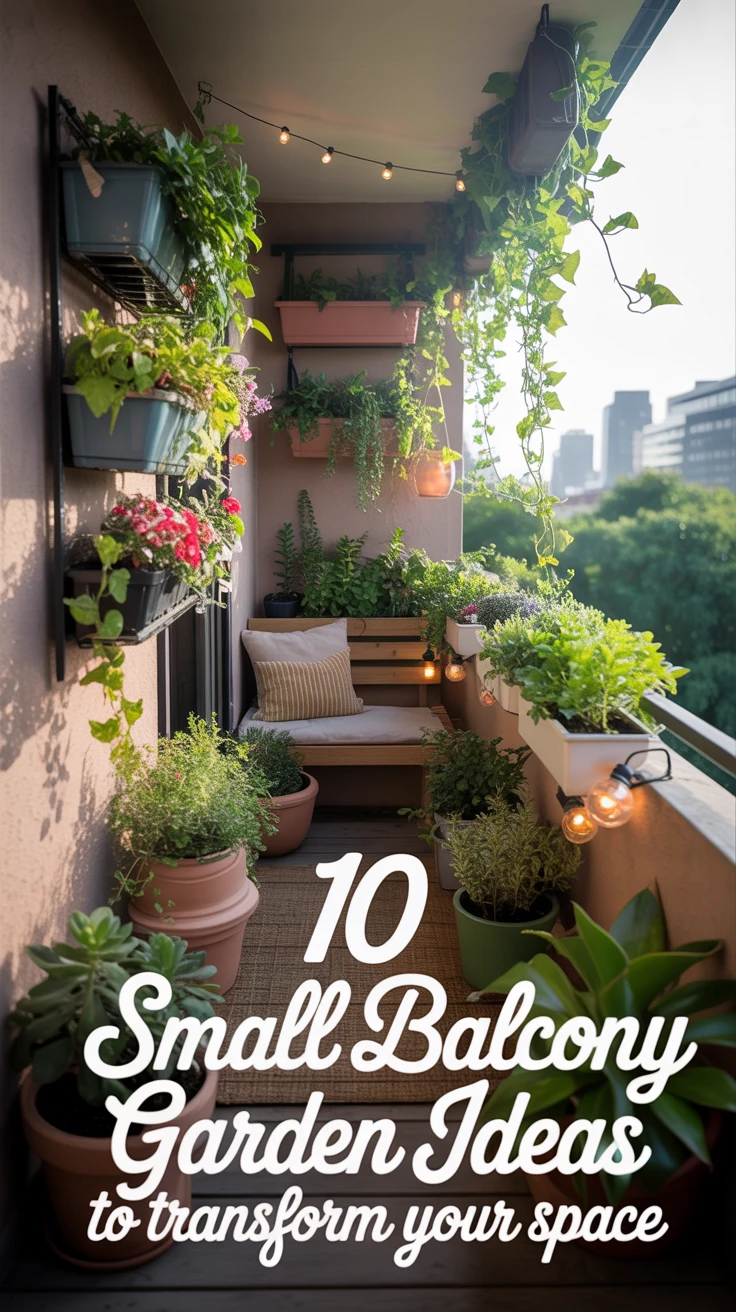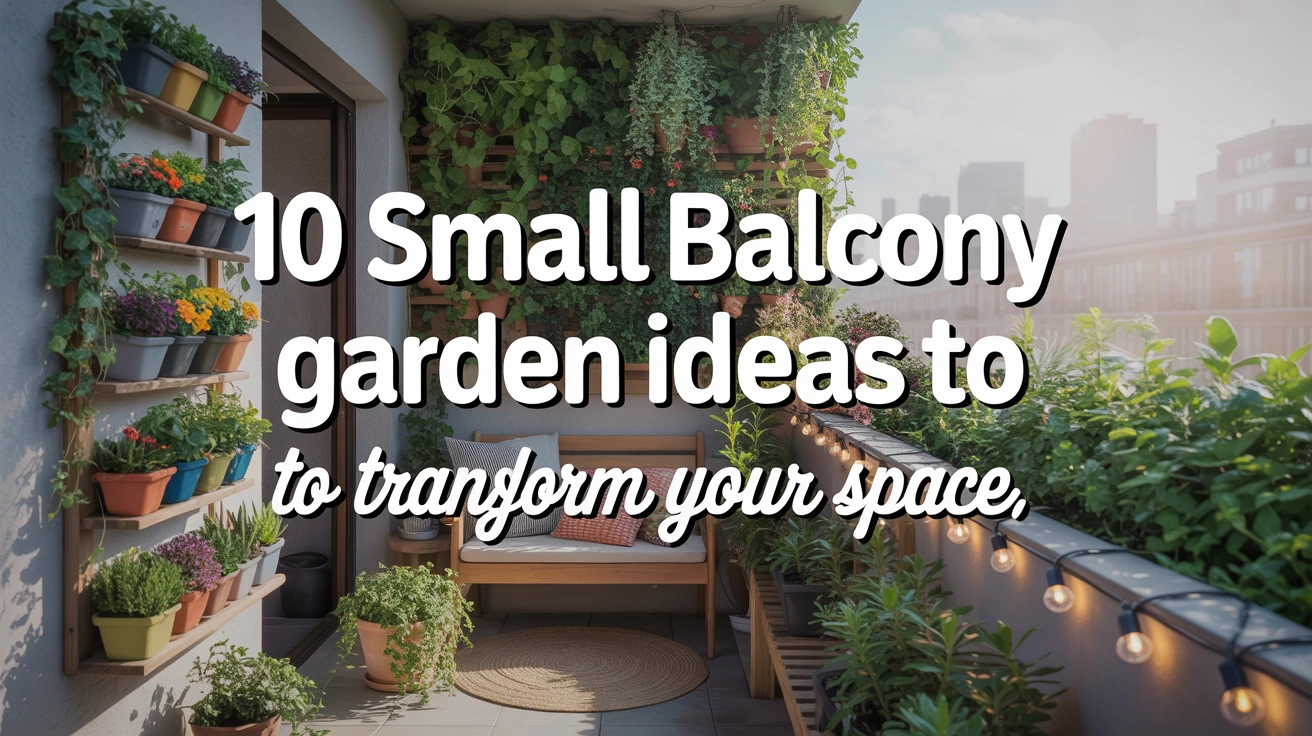
Introduction
Living in a city apartment doesn’t mean you have to give up your dreams of gardening. I’ve transformed countless tiny outdoor spaces into lush green retreats, and I’m convinced that small balcony garden ideas can work wonders for any urban dwelling. My own 4×6 foot balcony garden has become my sanctuary, proving that size truly doesn’t matter when it comes to creating a personal outdoor oasis. Whether you’re looking to grow fresh herbs, add some color to your concrete jungle, or simply create a peaceful retreat, these 10 ideas will help you maximize your limited space while expressing your personal style.
1. Vertical Gardening: Reach for the Sky
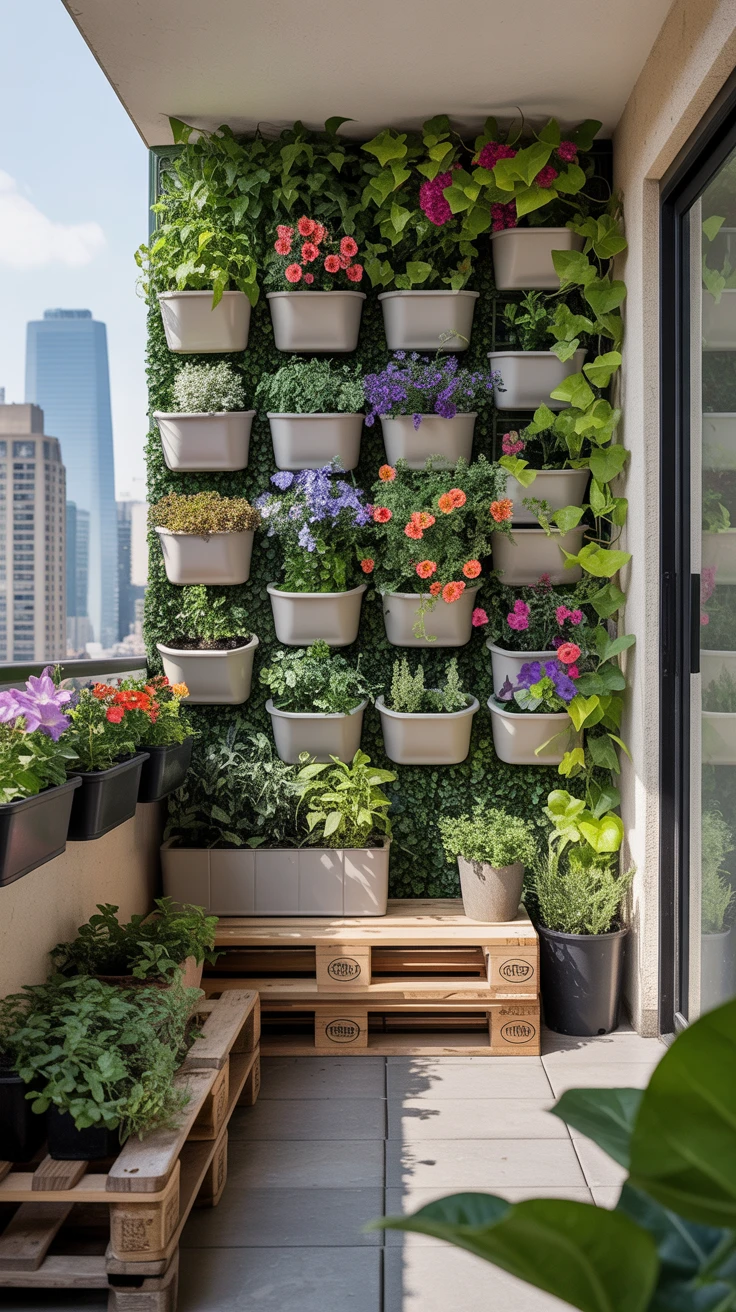
When I first started my small balcony garden, I made the rookie mistake of only thinking horizontally. Don’t repeat my error! Vertical gardening has been a game-changer for my tiny space, allowing me to triple my planting area without sacrificing precious floor space.
- Wall-mounted planters and pocket organizers
- Trellises for climbing plants like jasmine or morning glories
- Stackable planters that create a living wall effect
- Repurposed pallets converted into vertical gardens
- Grid panels with attached pots
I’ve found that climbing plants like ivy, clematis, and climbing roses work beautifully in vertical setups. They create a lush backdrop while leaving floor space open for seating or other containers.
Pro Tip: Always check the weight capacity of your balcony before installing vertical systems. I once learned this lesson the hard way when my overly ambitious wall garden caused some structural concerns. Use lightweight materials like plastic or fiberglass containers instead of ceramic or concrete when going vertical.
2. Container Gardening: Portable and Versatile
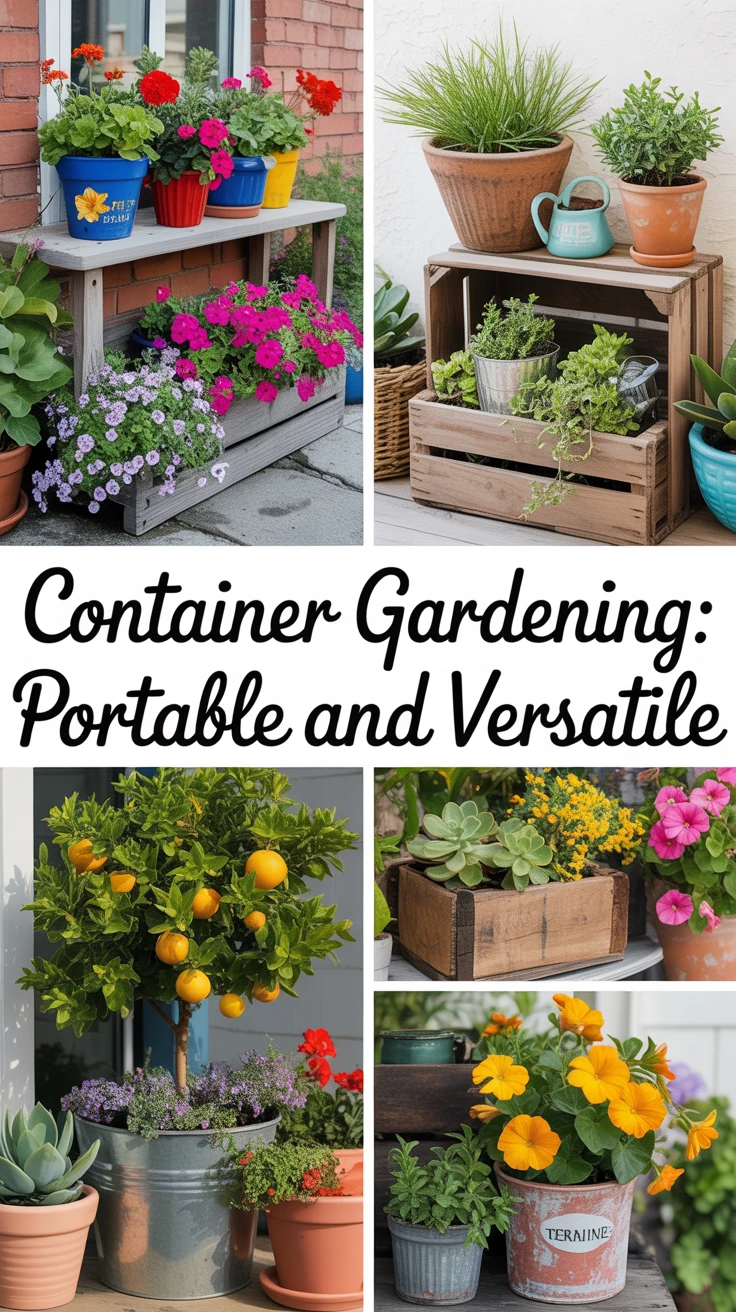
Container gardening offers incredible flexibility for small balcony gardens. I’ve experimented with countless containers over the years, from traditional terracotta pots to repurposed items like old teapots and wooden crates.
The beauty of container gardening is that you can move your plants around to catch optimal sunlight or rearrange your space for entertaining. I frequently shift my containers seasonally to ensure each plant gets what it needs.
- Best plants for containers:
- Geraniums – these resilient bloomers have survived even my most neglectful periods
- Petunias – cascading varieties create beautiful overflows
- Succulents – perfect for hot, sunny balconies
- Dwarf citrus – my lemon tree in a large pot brings me joy year-round
- Ornamental grasses – add movement and texture
Pro Tip: Group plants with similar watering needs together. I wasted countless plants before learning this simple trick. Now I have my “thirsty corner” and my “drought-tolerant zone,” making maintenance much more straightforward.
3. Hanging Planters: Utilize Overhead Space
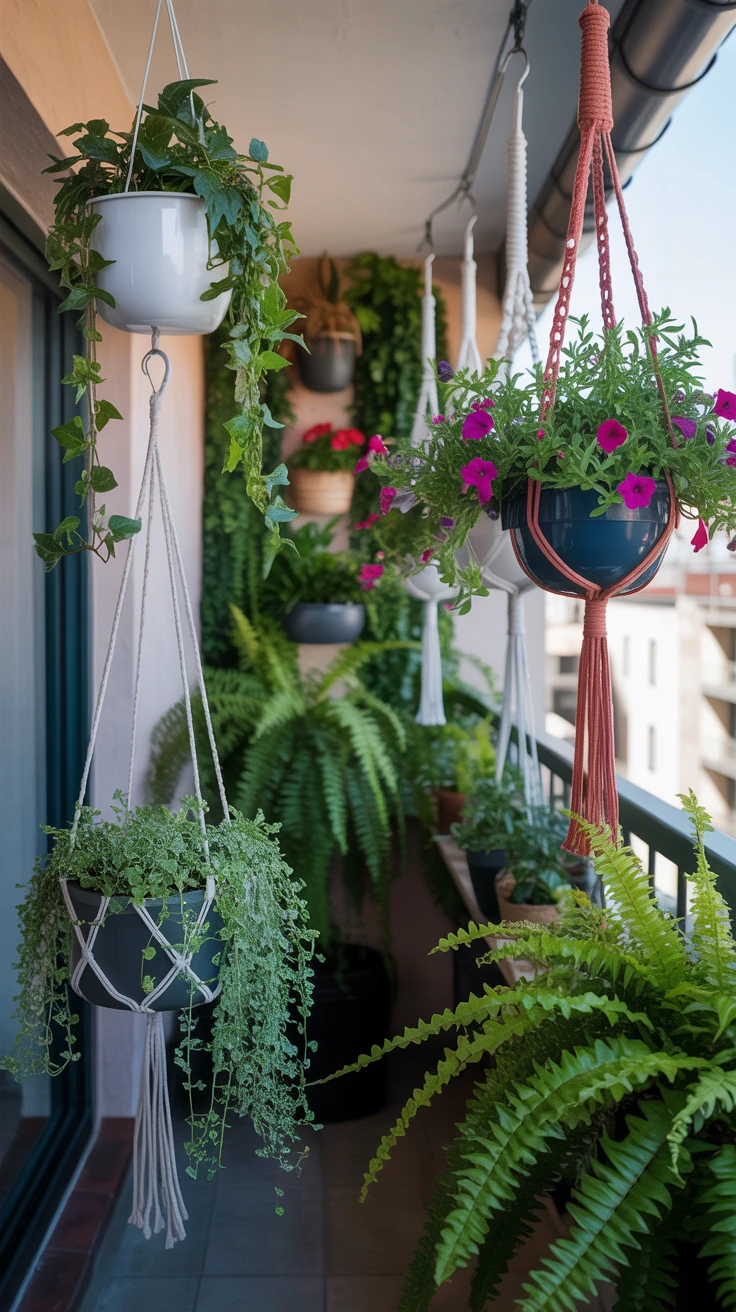
Looking up transformed my balcony garden. Hanging planters free up valuable floor and rail space while adding visual interest at eye level and above. I’ve installed hooks in my balcony ceiling to hang various planters, creating a canopy effect that makes my small space feel like a secret garden.
Cascading plants work beautifully in hanging arrangements. Some of my favorites include:
- String of pearls
- Trailing ivy
- Boston ferns
- Trailing petunias
- Spider plants
I’ve learned that macramé hangers add a bohemian touch while allowing you to adjust heights easily. For a more modern look, try geometric metal hangers that create interesting shadows as the sun moves across your balcony.
4. Herb Gardens: Fresh Flavors at Your Fingertips
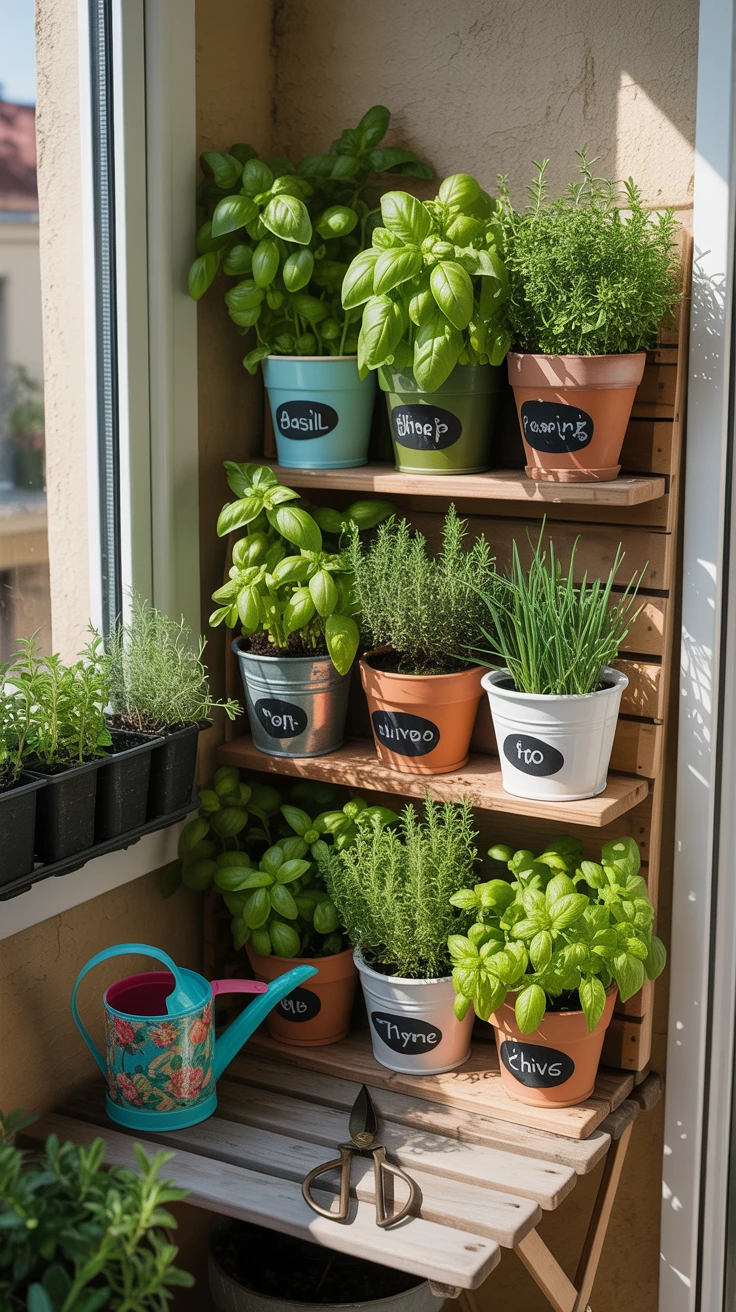
Nothing beats stepping outside to snip fresh herbs while cooking. My small herb garden has saved me countless trips to the grocery store and elevated my cooking tremendously. Herbs generally have shallow root systems, making them perfect for small containers and tight spaces.
Easy herbs to grow on a balcony include:
- Basil – my summer staple for fresh pesto
- Mint – contained in its own pot (it spreads aggressively!)
- Rosemary – drought-tolerant and aromatic
- Thyme – low-maintenance and versatile
- Chives – come back year after year with minimal care
Pro Tip: Create a dedicated herb spiral or tiered planter to maximize space while keeping herbs separate. I built a simple three-tier shelf using inexpensive wooden crates, which allows me to grow 8 different herbs in a 2×2 foot corner.
5. Edible Plants: Grow Your Own Produce
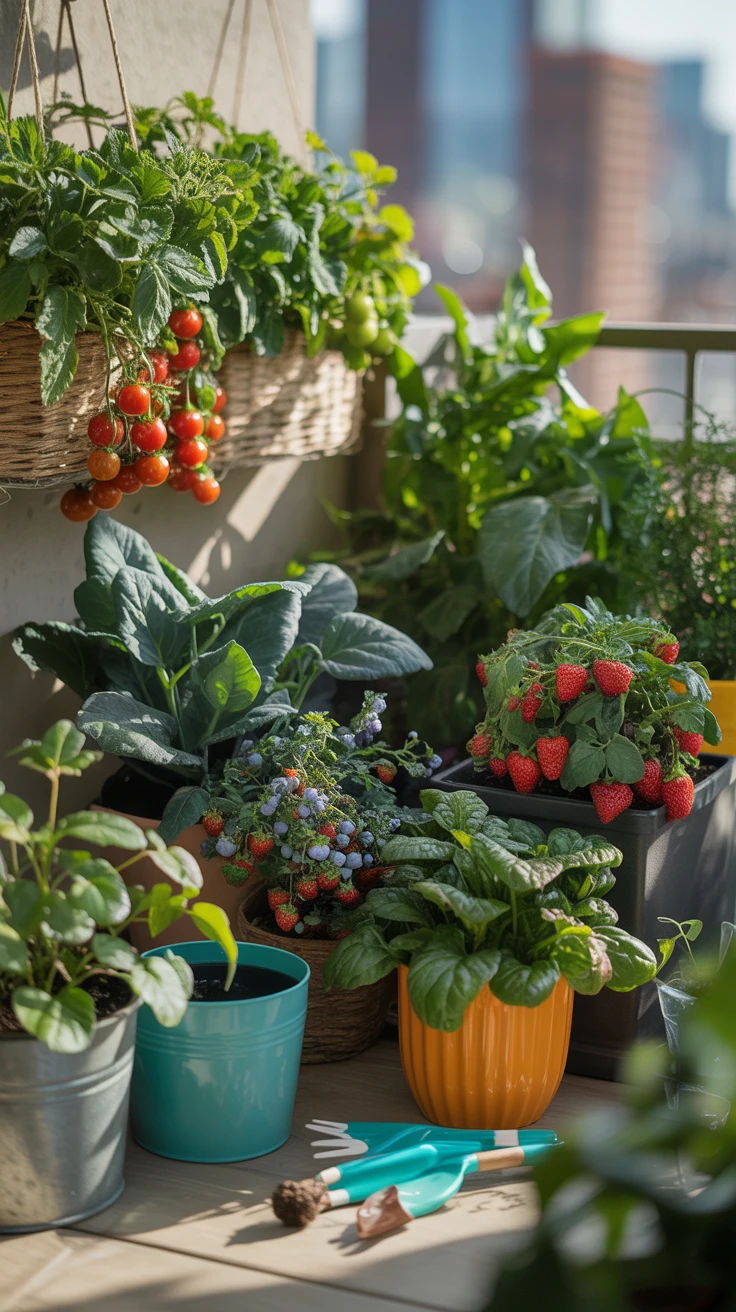
One of my greatest balcony gardening joys has been harvesting my own vegetables and fruits. There’s something incredibly satisfying about growing food in a small urban space. I’ve successfully grown cherry tomatoes, strawberries, and even a dwarf blueberry bush on my modest balcony.
Vegetables and fruits well-suited for balcony gardens:
- Cherry tomatoes (determinate varieties stay compact)
- Leafy greens like lettuce, spinach, and kale
- Bush beans rather than pole varieties
- Strawberries in hanging baskets or specialized strawberry pots
- Peppers, which thrive in containers and love the heat reflected off building walls
I’ve found that self-watering containers work wonders for edibles, as they require consistent moisture. My biggest mistake was underestimating how quickly vegetable containers dry out on hot summer days – a lesson learned after losing an entire crop of lettuce during a weekend away.
6. Multi-functional Furniture: Smart Space Solutions
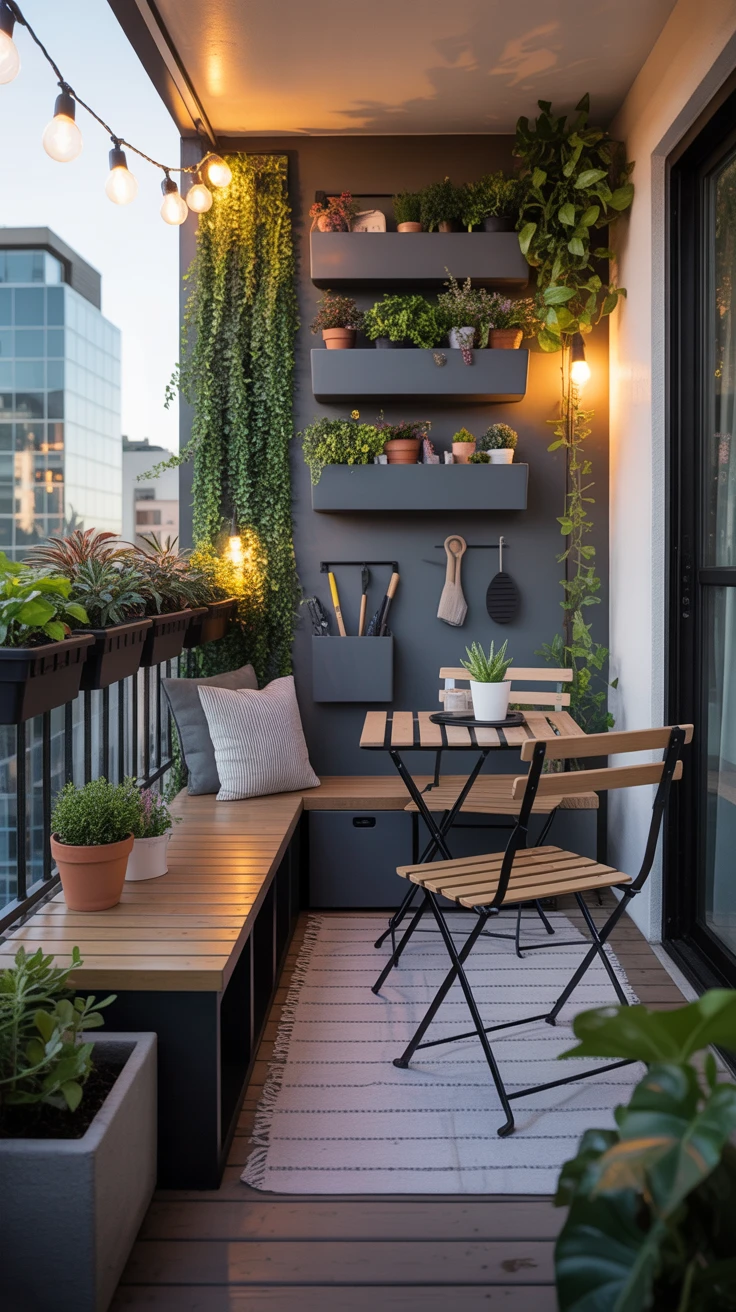
On a small balcony, every item needs to earn its place. I’ve become a big fan of furniture that serves multiple purposes. My favorite piece is a bench that opens to reveal storage for garden tools and supplies, with the top doubling as a potting surface when needed.
Consider these space-saving options:
- Benches with built-in planters at each end
- Railing planters that don’t take up floor space
- Folding tables and chairs that can be stored when not in use
- Vertical shelving units that provide both display space and privacy
Remember that your garden should include space for you to enjoy it! I made the mistake of filling every inch with plants at first, leaving nowhere to sit and appreciate my hard work.
7. Lighting Solutions: Extend Enjoyment Into Evening
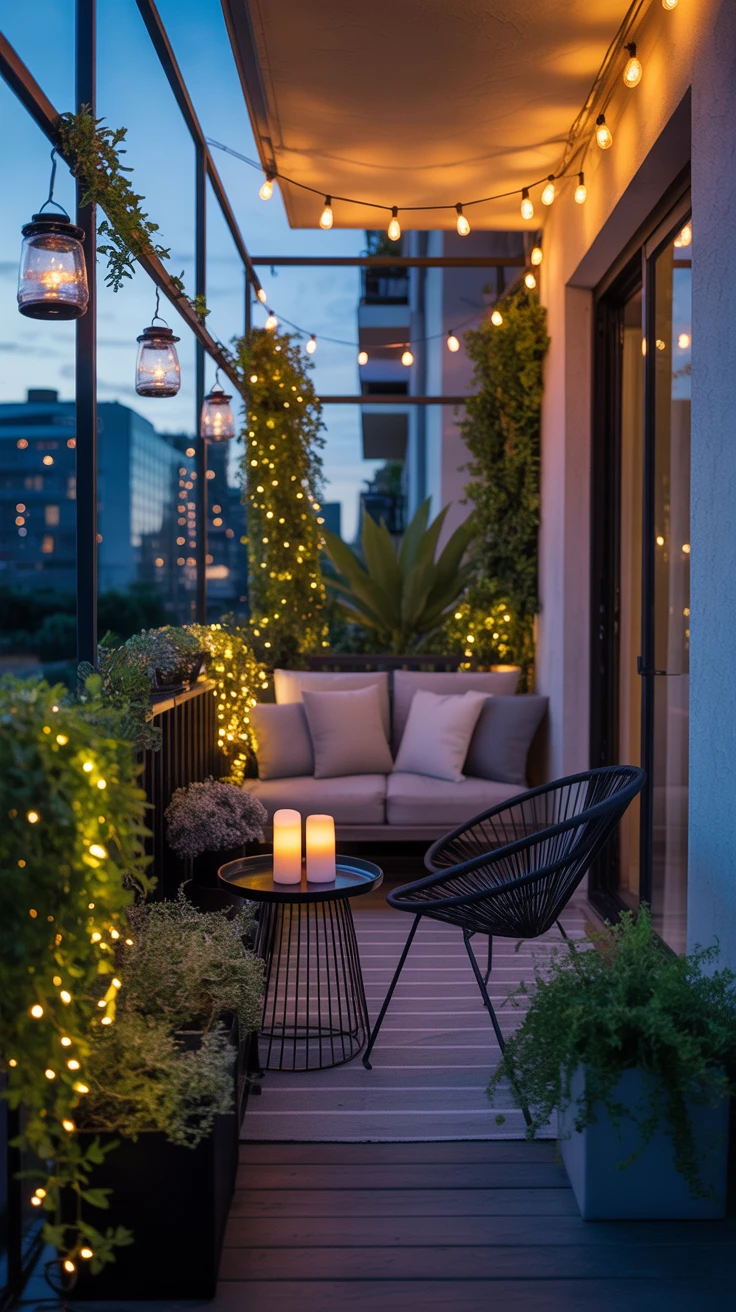
Proper lighting transformed how I use my balcony garden. Before adding lights, my outdoor space was essentially unusable after sunset. Now, with strategically placed solar lights, my balcony becomes a magical retreat in the evenings.
Solar-powered options eliminate the need for electrical outlets and reduce energy consumption. I’ve used:
- String lights weaved through railings and overhead structures
- Solar-powered lanterns hanging from hooks
- Small stake lights placed among plants
- LED candles for table ambiance without fire hazards
Pro Tip: Look for warm white lights rather than cool blue tones to create a cozy atmosphere. My first set of solar lights had that harsh blue-white glow that made my garden feel like a hospital corridor rather than a retreat!
8. DIY Garden Decor: Personal Touches
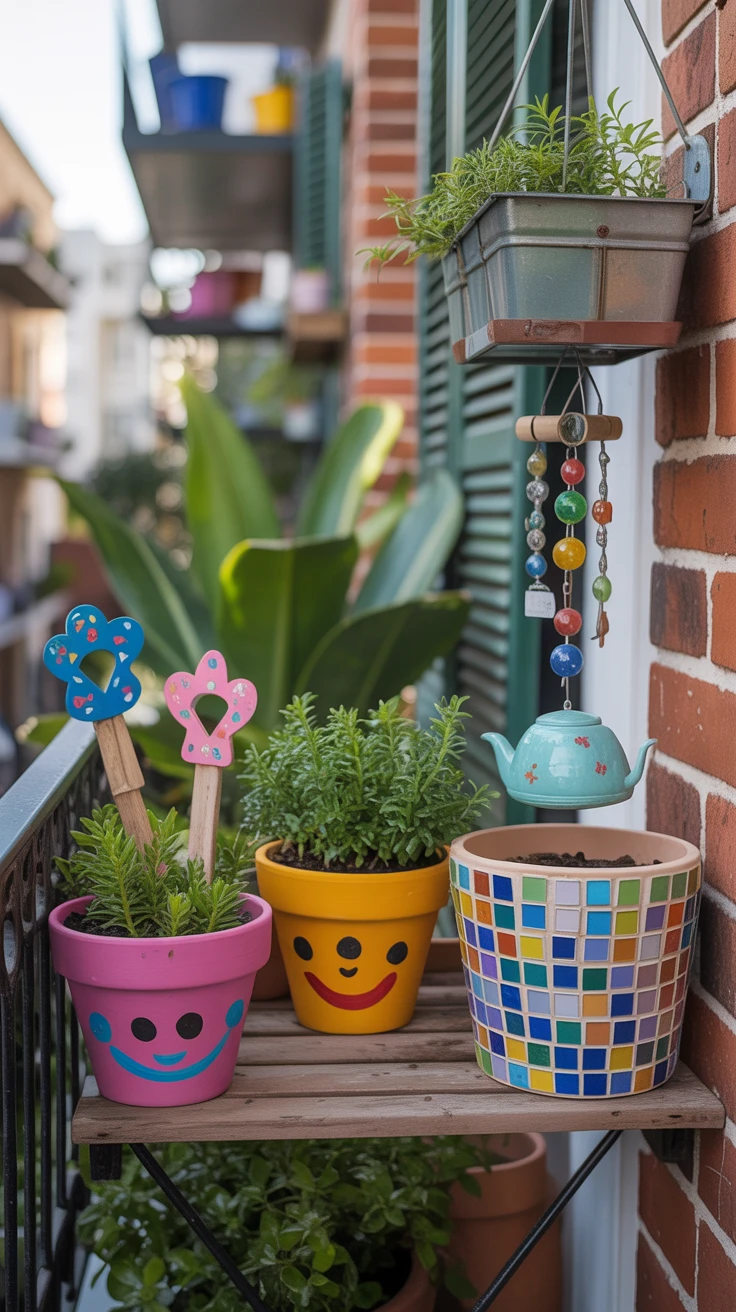
Adding personal touches to your small balcony garden makes it uniquely yours. I’ve incorporated several DIY projects that cost little but add significant character. My painted terracotta pots bring color throughout the seasons, while my homemade wind chimes add gentle sound.
Simple DIY projects to try:
- Painted pots or containers
- Mosaic tile decorations on plain planters
- Repurposed items as planters (old boots, colanders, wooden crates)
- Homemade bird feeders to attract wildlife
- Decorative plant stakes or markers
These personal touches make my garden feel like an extension of my home rather than just an outdoor space.
9. Seasonal Plants: Year-Round Interest
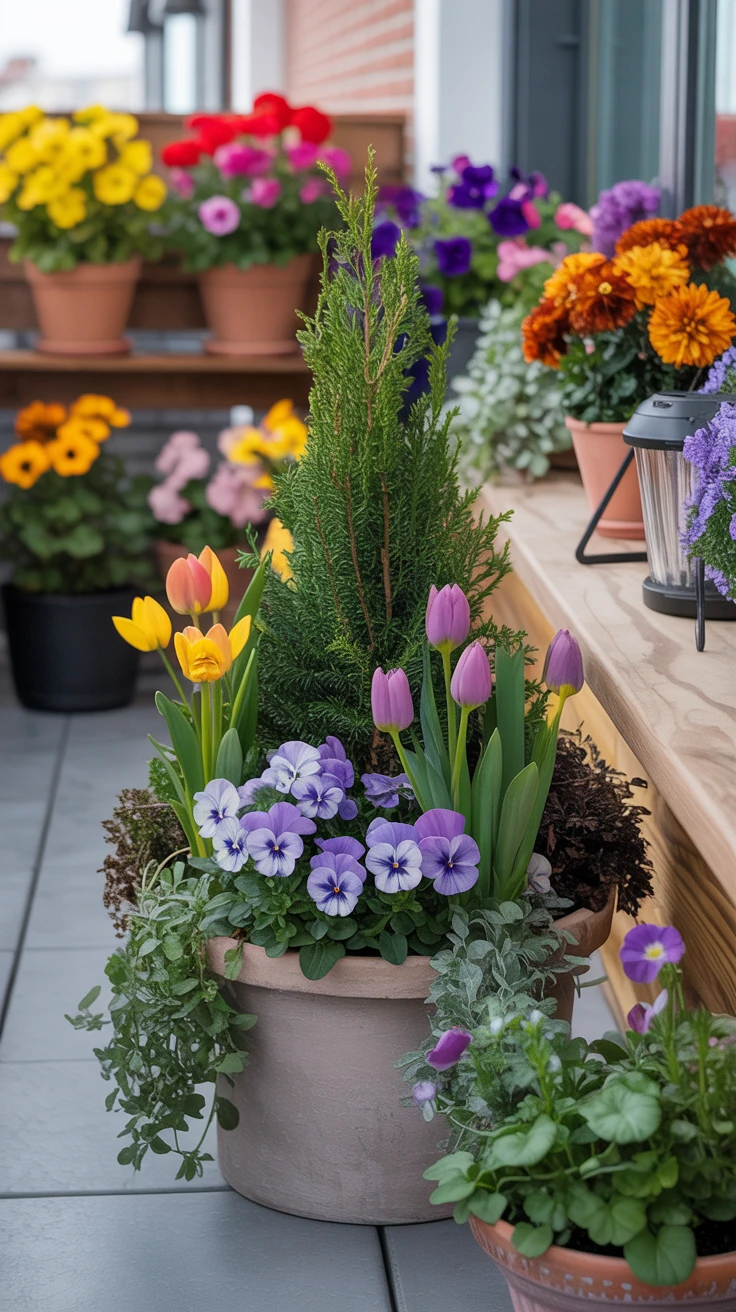
One mistake I made early on was planting only summer bloomers, leaving my balcony looking bare for much of the year. Now I plan for continuous interest with a mix of plants that shine in different seasons.
- Spring: Tulips, daffodils, pansies, primroses
- Summer: Geraniums, petunias, verbena, calibrachoa
- Fall: Chrysanthemums, ornamental kale, asters
- Winter: Evergreens, winter pansies, hellebores
I keep a few large containers with permanent plantings of small evergreens or grasses, then surround them with seasonal bloomers in smaller pots that I can easily swap out.
10. Maintenance Tips: Keep Your Garden Thriving
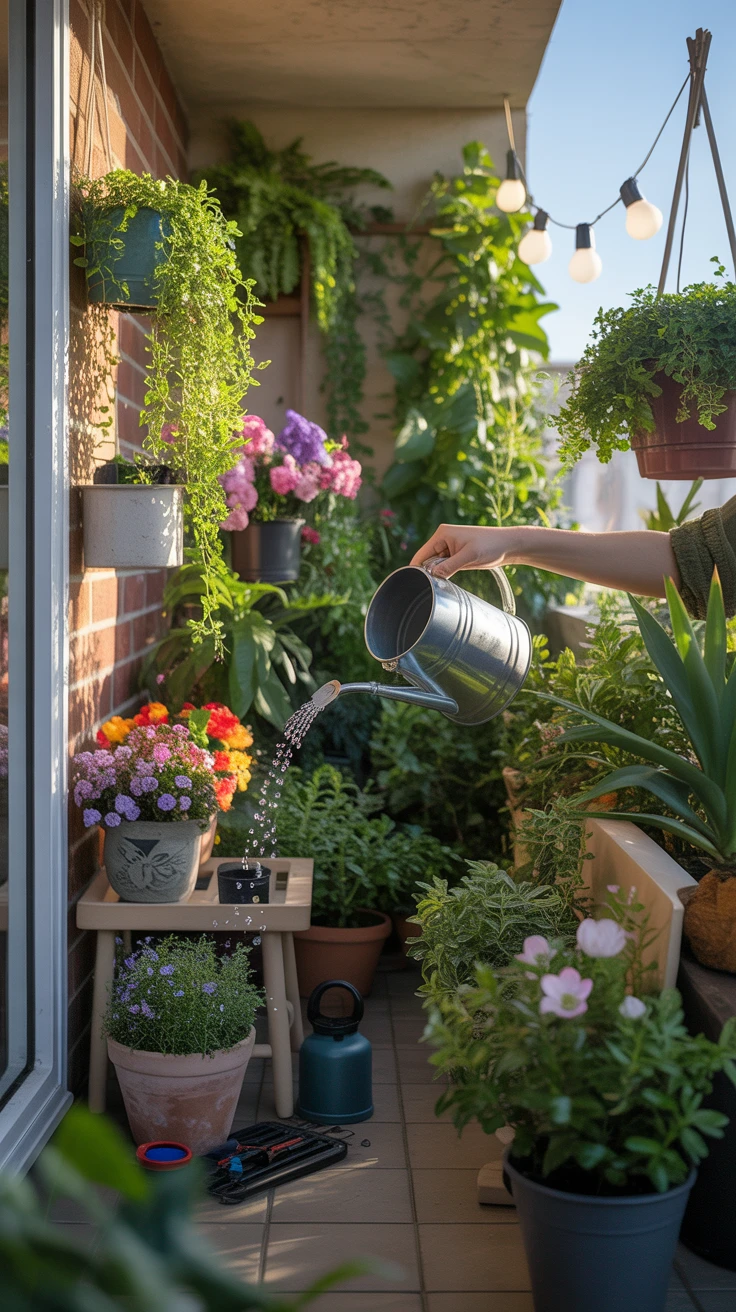
Maintaining a small balcony garden requires consistent attention, but it doesn’t have to be overwhelming. I’ve developed a simple routine that keeps my plants happy without consuming my weekends.
- Water deeply but less frequently to encourage strong root growth
- Install a simple drip irrigation system for vacations (after losing plants during a two-week trip)
- Use high-quality potting mix specifically formulated for containers
- Fertilize regularly during growing season (I use a diluted liquid fertilizer weekly)
- Prune and deadhead to encourage continuous blooming
- Inspect regularly for pests – catching problems early is crucial in small spaces
Pro Tip: Invest in self-watering containers for thirsty plants or if you travel frequently. They’ve been lifesavers for my herb garden and vegetable containers, providing consistent moisture without daily watering.
Frequently Asked Questions
What are the best plants for a north-facing balcony with limited sunlight?
For low-light balconies, focus on shade-tolerant plants like ferns, hostas, impatiens, begonias, and coleus. I’ve had great success with caladiums and peace lilies on my north-facing balcony section. Remember that even “shade plants” need some indirect light to thrive.
How can I prevent soil from washing out of my containers when it rains?
I place a coffee filter or piece of landscape fabric at the bottom of pots before adding soil, which allows water to drain while keeping soil in place. For heavy rain, consider placing saucers under containers or creating a slight depression at the top of the soil rather than filling containers to the brim.
What’s the easiest way to deal with pests on a balcony garden?
Prevention is key! I inspect new plants carefully before bringing them home and isolate them for a week to ensure they’re pest-free. For active infestations, I’ve had success with neem oil spray for most common pests. For serious problems, remove affected plants quickly to prevent spread in your confined space.
How do I protect my balcony plants from strong winds?
Wind protection has been crucial for my 10th-floor balcony. I use windbreaks like bamboo screens or trellises, place delicate plants in sheltered corners, and avoid top-heavy containers. During extreme weather, I temporarily move vulnerable plants indoors or closer to the building wall.
What’s the best way to maximize limited balcony space?
Think three-dimensionally! Use walls, railings, ceiling space, and multi-level planters. My balcony uses every vertical inch with wall planters, hanging baskets, and tiered shelving. I also recommend multi-functional items like storage benches and nesting tables that can be expanded when needed.
